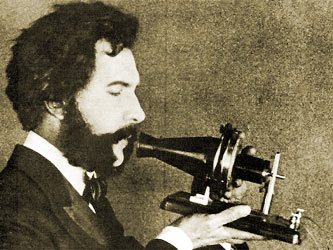 |
Telephone and |
||||||
Vibraphone / Telephone (1875 - 1879) |
In 1875, Bell makes a first prototype of the vibraphone. The apparatus is actuated using mobile a metal strip, similar to those of the clarinets. In March 1876, Bell improves quality of the vibraphone by replacing the strip by a wire plunged in a container filled of water and acid. The liquid produces module the intensity of the current in the wire in a way equivalent to the sound waves of the atmosphere. |
Bell visits eminent scientist Joseph Henry at the Smithsonian Institution and explains to him his idea for the telephone, in march, 1975. J.Henry recognizes the significance of Bell's work and offers him encouragement. In September 1875, he began to write the specifications for the phone. 14 february 1876, Bell's telephone patent application is filed at the United States Patent Office. |
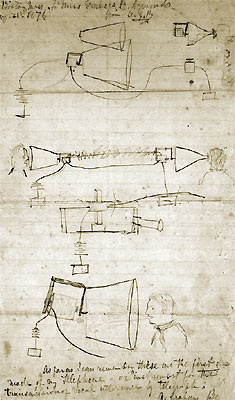 |
|
|
Elisha Gray, American inventor of the Telegraph for Transmitting Musical Tones, files a record of caveat (notice of patent) for a phone just a few hours later. United States Patent No. 174,465 is granted on March 7, 1876 to Alexander Graham Bell, before even as his telephone does not function perfectly. Elisha Gray then brought several lawsuits, all of which result in a judgment against him. It’s in March 10, 1876, in Boston, the apparatus produced by Alexander Graham Bell, called vibraphone, succeeds for the first time remotely transmitting the voice of his inventor, when intelligible human speech is heard over the telephone for the first time when Bell calls to Watson, "Mr. Watson -- Come here -- I want to see you." June 25,1976, Bell demonstrates the telephone for Sir William Thomson (Baron Kelvin) and Emperor Pedro II of Brazil at the Centennial Exhibition in Philadelphia. |
|
The first telephone exchange in the United States opens in New Haven, in 1878, under license from Bell Telephone. Within a few years, licensed telephone exchanges open in every major city in the country. January 14, 1879, Bell demonstrates the telephone for Queen Victoria. |
||
And the 12 february 1879, the Bell Telephone Company merges with the New England Telephone Company to become the National Bell Telephone Company, then the American Bell Telephone Company, the following year. By 1894, Alexander Graham Bell's second telephone patent expires, opening the telephone industry to competition |
Within a decade, over 6,000 companies went into the telephone business across the country. January 25, 1915, held the opening ceremony of the transcontinental telephone line, and to give it more prestige, it is Bell in New York (Office of the American Telephone and Telegraph Company) and Watson in San Francisco, who are invited to make the first transcontinental phone call! (photo on the right). When Alexander Graham Bell dies in 1922 in his house of summer of Baddeck, thirteen million telephones are already sold. June 2002, the U.S. House of Representatives officially recognized the role of the Italian-American Antonio Meucci in the invention of the telephone. Indeed, in 1989, Basilio Catania, ex-Director General of CSELT (the research agency and development of Italian telecoms), discovers the work of Antonio Meucci. Until then, nobody had ever questioned the paternity of Bell invented the telephone. December 12, 1871, Antonio Meucci founded the Telettrofono Company with three partners and 28 December, he protects his invention (Telettrofono) by a "warning patent" formula renewable cheaper than a patent. For lack of financial resources, Meucci is seen unable to renew it before its expiry, in 1874. Two years later, in 1876, Bell filed his patent. Convinced of having stolen his invention, Meucci suing him. The trial lasted until 1889, when the death of Meucci ends proceedings, without the inventorship of the phone is recognized in him. The U.S. House of Representatives said that "if Meucci had been able to pay the $ 10 fee to keep the promise of patent after 1874, no patent could have been issued to Bell" |
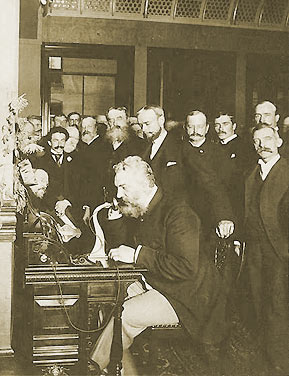 |
The word telephones car its origin of the Greek words têle and phônê, literally "remote voice". The telegraph term results from the Greek têle and graphos, for "remote writing". In the honor of Alexander Graham Bell, the measuring unit of the sound power, adopted in 1927, the name of decibel will carry |
Photophone (1880) |
In 1880 the French Government awards Bell the Volta Prize of 50,000 francs, for the invention of the electric speaking telephone. He uses the prize money to set up the Volta Laboratory as a permanent, self-supporting experimental laboratory devoted to invention. With his young associate, Charles Sumner Tainter, he invent the photophone and he took the opportunity to present it the Meudon Observatory. The photophone can produce and reproduce sound by using the properties of selenium and has nothing in common with the transmission of pictures. December 14, 1880, they get two patents on the preparation of selenium cells. |
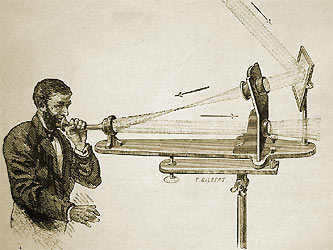 |
That year they deposited at the Smithsonian two sealed tin boxes containing models and documentation of a device they called a photophone, which transmitted sound over a beam of light, and other apparatus. The inventors hoped that the sealed boxes would prove their priority in invention; they did not want to file a patent for fear of giving away secrets that would help competitors. One can imagine that it could be the strategic and commercial importance of such a discovery: once perfected, it would have allowed the establishment of a optics telephone system that does not require construction of a telephone network. It is therefore not without reason that Bell considered until his death that this invention was superior to that of the electric telephone. |
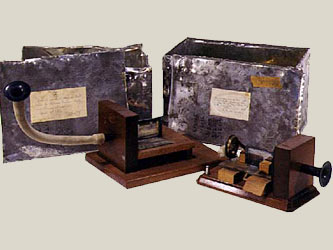 |
photophone au Smithsonian |
When the boxes were finally opened in 1937, long after Bell's death, the inventions inside were historical relics, not technological breakthroughs. But it will be mainly the work conducted in 1960 on the laser beams, resulting in particular in 1978 the launch of the Compact Disc Audio, which show that the hypothesis of Bell - transmit sound through the light - was no absurd |
Telectroscope (distance vision) |
Louis Figuier, great popularizer French scientist, dedicates a long article about the phone in the volume 1877 : “year of Scientific and Industrial Research”, Twenty-first year, Librairie Hachette and Co., Paris, 1878. But most astonishing is that this article is immediately followed by another article entitled "The telectroscope, a device to transmit distances images", which assigns to Graham Bell invented this device. There is no known trace Bell's contribution of telectroscope on that date. Figuier himself seemed skeptical, since it ends the article by writing "... although it would take accurate descriptions of the device to believe in this announcement ". This attribution is only a fanciful illustrations of the movement of imagination sparked by the announcement of the arrival of the phone: if it is possible to transmit sound by electricity, it should also be possible to transmit pictures. In Europe, the two pioneers of research on this subject will, in 1878, Portugal's Adriano de Paiva and French Constantin Senlecq. Both recognize that this is the announcement of the development of the electric telephone by Bell, which stimulated their work. The term Telectroscope fell into disuse after the introduction in 1900, the word television |
| Source : Smithsonian Institution - Fitzgerald Canada - Parks Canada - AT&T - National Geographic Magazine (Vol. XIV, No.6, June 1903) - Alexander Graham Bell National Historic Site - Dictionary of American Biography Base Set. American Council of Learned Societies, 1928-1936. Photos : Library and Archives Canada - Library of Congress American Memory - Smithsonian Institution - National Geographic |
Telephone and |
||||||
